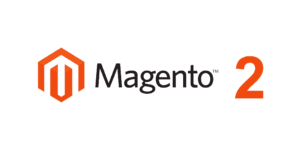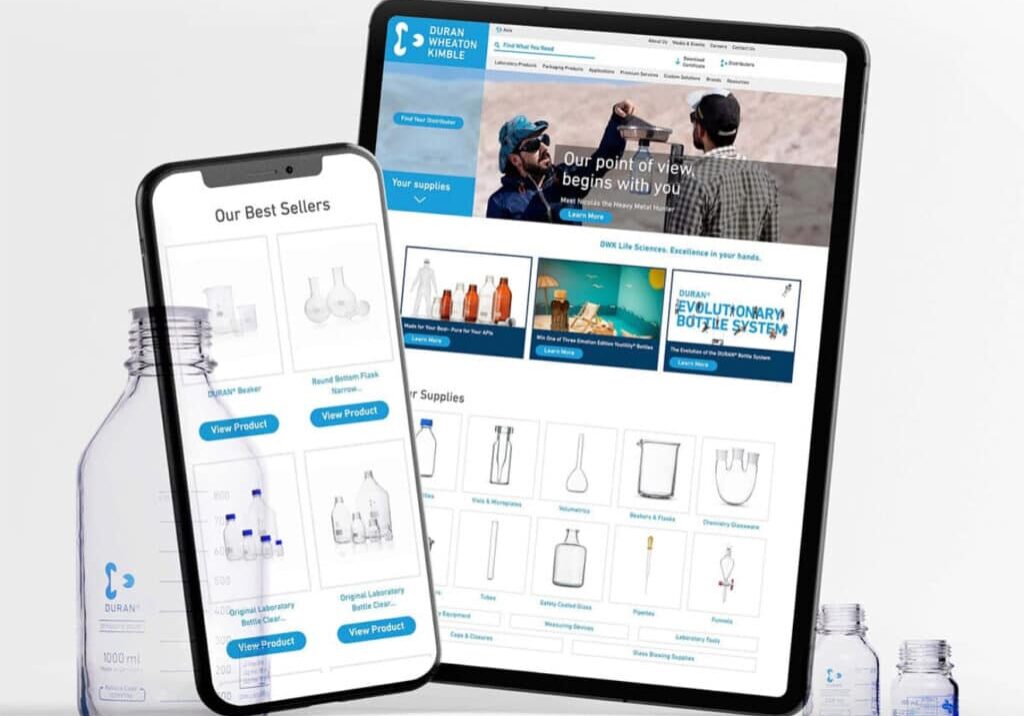Digital Strategy, Web Development
11 Minutes
Life Science Web Technology Trends & Tools
Top 10 For Life Science: CMS, eCommerce, Analytics, Hosting
Do you know what digital marketing and analytics tools your top competitors in life science are using?
We are constantly asked by clients what digital marketing tools they should use. These tools include web platforms, content management systems, eCommerce frameworks, CRMs, marketing automation platforms, analytics tools, and more. There are so many to choose from. It can be a significant investment, as well as a risk in both time and resources, to choose tools that aren’t the right fit for your company.

At Supreme, we believe deeply in not only working hard, but really doubling-down on working smart. We know how much easier it is to grow a business digitally and compete in the marketplace when we have the right web platform and meaningful data-points to work with.
That’s why over the last month we’ve been working hard to compile the most complete dataset you’ll find anywhere, one that reveals the most popular digital tools used by life science companies today.
We conducted a deep dive of 70 life science companies ranging from SMBs to enterprise-level companies, and then we sorted the data to show you the most popular tools and platforms being used today. We utilized a few key tools to access this data, including BuiltWith, SEMrush, and SimilarWeb.
The findings below will help you answer a few key questions:
What web platform should I build my new marketing website on?
What web platform should I build my new eCommerce website on?
What analytics and tracking tools should I leverage to make data-driven decisions to better understand and optimize my customer’s journey?
Where should I host my website for the best performance?
Let’s dive right in!
The findings below will help you answer a few key questions:
- What web platform should I build my new marketing website on?
- What web platform should I build my new eCommerce website on?
- What analytics and tracking tools should I leverage to make data-driven decisions to better understand and optimize my customer’s journey?
- Where should I host my website for the best performance?
Let’s dive right in!
1. Marketing Web Platforms
(Content Management Systems)
Top Content Management Systems Distribution across the Top 10K Websites Globally
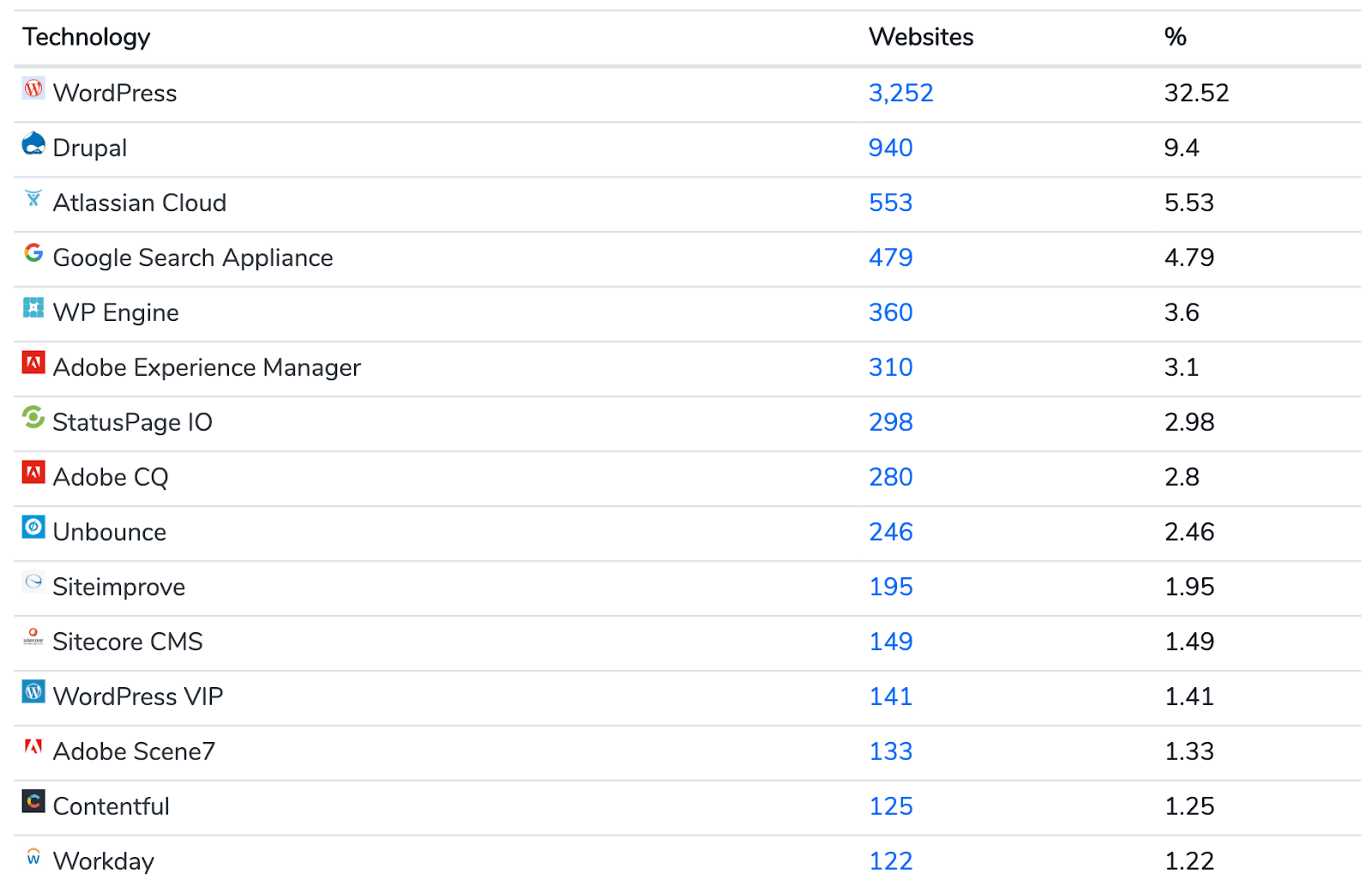
You’ll notice there are a number of other technologies that are grouped into content management systems that will support content management. But they can often be misclassified. The key players are really WordPress, Drupal, Adobe Experience Manager/Adobe CQ, and Sitecore CMS.
The Top 10 Content Management Systems Used by Life Science Companies

WordPress leads in this category, which is no surprise. Drupal comes in at second, both globally and for life science companies. Sitecore CMS is the only other content management system that is in the running in the life science industry. WordPress and Drupal are both open-source, free-of-charge for anyone, anywhere. Sitecore CMS is a proprietary platform that is built by a privately-held company with some nice built-in digital marketing features that Drupal and WordPress lack out-of-the-box.
The bottom line is that WordPress is an excellent choice for a very user-friendly backend with a large amount of free or paid plugins to suit more-or-less all of your needs as an SMB-life science company. Most companies we work with want to be able to easily manage certain updates themselves. WordPress offers easy-to-use content management better than anyone else.
Drupal offers the flexibility to create extremely complex websites (with a steep learning curve and cost) that may be overkill for most life science companies in today’s marketplace.
Sitecore is a niche-platform that can be an excellent choice for highly sophisticated enterprise-level companies that have a very strong understanding of advanced digital-marketing concepts and are able to leverage the “digital marketing suite” that Sitecore comes with.

Our Pick: Top Content Management System |
|
|---|---|
|
WordPress 
|
|
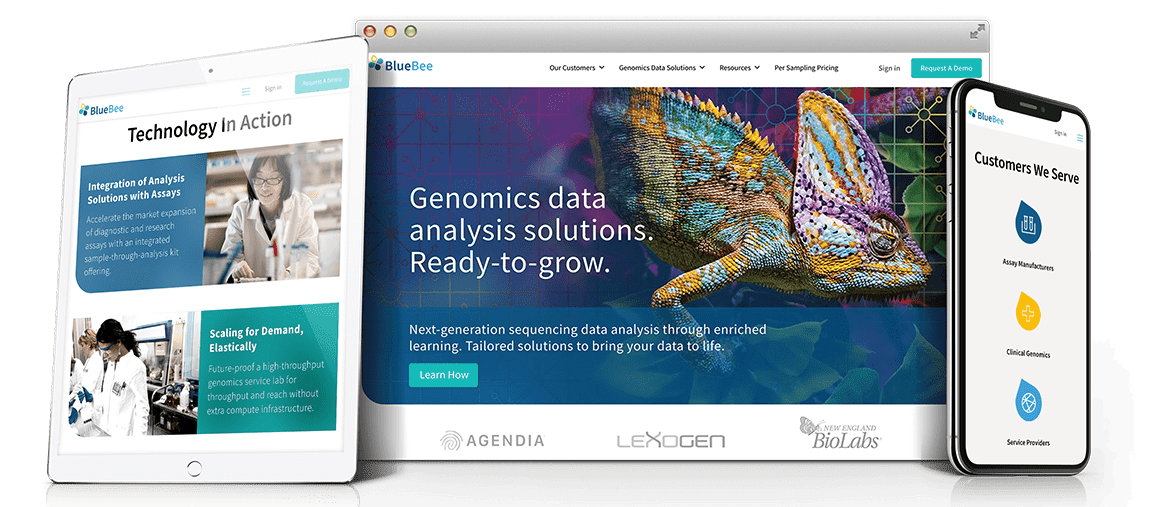
BlueBee’s new website is a custom-designed site by Supreme, built on WordPress.
2. eCommerce Platforms
Top eCommerce Platforms Distribution across the Top 10K Websites Globally

Shopify in recent years has changed the game when it comes to enabling small to medium-sized B2C companies to easily setup an eCommerce website with solid UX/UI. Magento Community Edition and Magento Enterprise (Commerce) is a close second, which is primarily catered toward B2B-shopping experiences. There’s a number of other key contenders including Salesforce Commerce Cloud, Demandware, SAP Hybris and more.
Top eCommerce Platforms Used By Life Science Companies
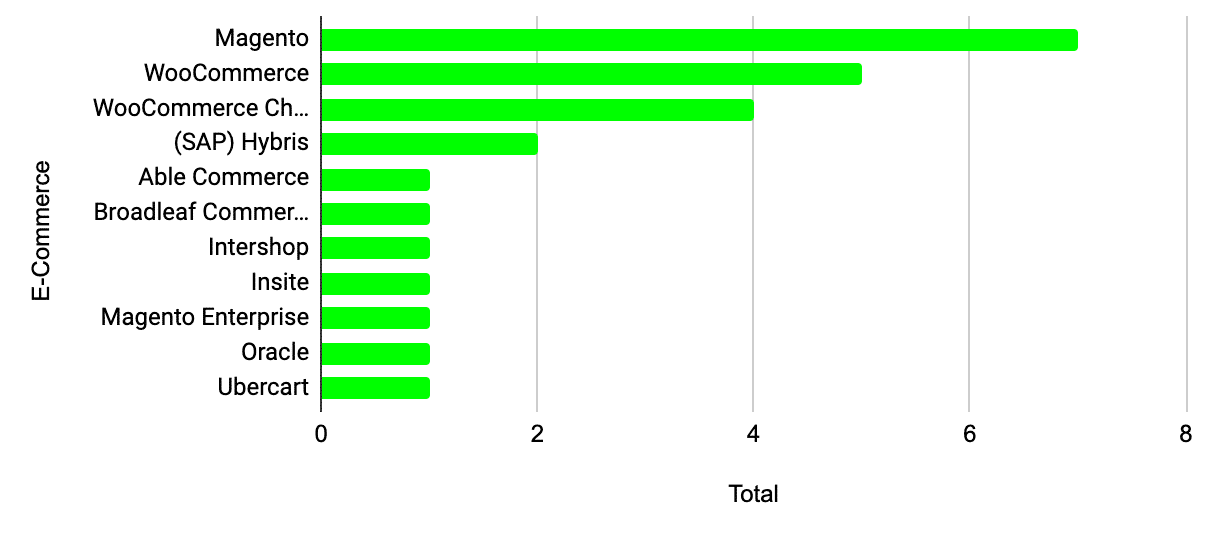
Within Life Sciences, the most common eCommerce platform is… uncategorized as “Cart Functionality.” In other words, there exists a checkout cart functionality but it isn’t associated with any main cart technology that BuiltWith.com tracks.
Why is this the case?
In my experience, life science companies lag behind tremendously when it comes to eCommerce and digital transformation. The vast majority of companies that I’ve worked with either have, or had in the last couple years, a custom-built eCommerce solution to fit their needs. Of course, when it comes to newer functionality, integrations, SEO, search, and content management, these “hacky” solutions just don’t cut it anymore.
In second place (after “Cart Functionality”) we see Magento and in a distant third place is SAP Hybris. Notice that we don’t see Shopify anywhere on the list. Shopify was built as an amazingly easy to use B2C platform, but it just doesn’t cut it when it comes to all the B2B features and integrations that life science companies need. This is even truer when it comes to complex product-data attributes.

The bottom line is that Magento Community Edition and Magento Commerce (now owned by Adobe) is the fastest growing and the leading option for life science companies to build on. Magento’s Open API and open-source code platform provides limitless flexibility with the ability to integrate with ERPs, PIMS, CRMs and more with relative ease.
SAP Hybris can be a contender if and only if SAP is the ERP system you are currently using. The implementation cost can easily triple compared to a Magento implementation, but in some business situations an argument can be made that it is best to use SAP’s eCommerce solution with their ERP.
In my opinion, with the right team, Magento can definitely compete with SAP Hybris when it comes to having tight-knit ERP integrations. There is no question that Magento is a substantially more powerful eCommerce platform. It is an unrivaled developer ecosystem when it comes to digital marketing, SEO, and soon to be much more with personalization through the support of the parent company Adobe’s ecosystem.
Dark horse: Salesforce Commerce Cloud (Demandware). Salesforce Commerce Cloud, although not adopted in the life sciences space due to significantly higher costs and a lower degree of flexibility and agility, is one of the most popular enterprise-level eCommerce platforms. It is at position #3, right after Magento.
The key benefit here is their proven success with giant household names and omni-channel capabilities, which streamline operations and marketing potential. That being said, knowing what I know about where life science companies are in digital transformation, the features are nice but they come at a cost, especially when they aren’t ready to be used. Personally, I fully expect Adobe Magento Commerce to be able to strongly compete with all the native solutions that Salesforce Commerce Cloud offers today as part of their SaaS solution.
TIP: There are still so many life science companies building their eCommerce shops on WordPress and WooCommerce. Here’s a tip worth more than $100K. Stop. Don’t do it. To the companies that are built on WooCommerce, if you want to take the business seriously, at some point you’ll have to make the upgrade to a real eCommerce platform, sooner or later.

Corning Life Sciences’ eCommerce portal is built on SAP Hybris. It’s a separate website (subdomain) found at ecatalog.corning.com. Unfortunately, it is not the optimal web experience and it dilutes SEO ranking potential.

STEMCELL Technologies was built on Magento Commerce, which unifies both a content management system and an eCommerce platform into one easy-to-use experience, as opposed to Corning Life Sciences.
Our Pick: Top eCommerce Platform |
|
|---|---|
|
Magento 2
|
|

Glen Research is an example of a Magento 2 website that Supreme designed with easy-to-use and highly-functional search and filtering elements.

Glen Research is an example of a Magento 2 website that Supreme designed with a user-intuitive and highly-functional product detail page.
3. Analytics and Tracking
Top Analytics and Tracking Tools Distribution across the Top 100K Websites Globally
Analytics and tracking has a giant set of tools that can be used to help companies capture and make the most sense out of their data. Most companies use a large variety of these tools simultaneously and for different purposes. These tools span a number of key sub-categories, including A/B Testing, Advertiser Tracking, Audience Measurement, Call Tracking, Cart Abandonment, CRM, Conversion Optimization, and much more.
As a whole, everyone pretty much uses Google Analytics, and they often use Google Conversion Tracking with it. Beyond that, if you’re doing Facebook advertising, then Facebook pixels are a must. Aside from these two, NewRelic, Rapleaf (now TowerData), LiveRamp, and Hotjar are probably the most relevant in this conversation.
NewRelic has a variety of benefits for technology businesses, especially eCommerce. It essentially allows you to track better and to make sense of problems and opportunities on an eCommerce website for a superior digital customer experience. At the scale of large retail and eCommerce businesses, small improvements in conversion rates and stickiness such as a fraction of a percent can mean the difference in millions of dollars of revenue.
Rapleaf (TowerData) helps you better understand the people behind your email list when it comes to real name, demographic information, income, and other personal details. This is probably not that relevant for the life sciences space in the whole scheme of things because, generally speaking, the companies we work with are B2B.
LiveRamp allows you to combine data from multiple data sources into a single source of truth. Then you can utilize this data to tie to an omnichannel identity, which will enable you to better target consumers, or in our case, decision makers on a single account. I haven’t personally used LiveRamp because it’s still a stage above the current sophistication of the clients we work with, but that’s definitely something to be explored via their B2B Marketing Solutions.
Hotjar is probably the most relevant for companies in the life science space. The idea is simple. Use Hotjar to gather quantitative data on web visitor behavior through heatmaps, recordings and conversion funnels. Then, use their feedbacking system to collect qualitative feedback to help improve web experience.

Other honorable mentions when it comes to more specific subcategories under Analytics and Tracking include:
CRM: Zendesk, Salesforce
Call Tracking: CallRail
Error Reporting: BugHerd, BugSnag
Top 10 Analytics and Tracking Tools Used by Life Science Companies
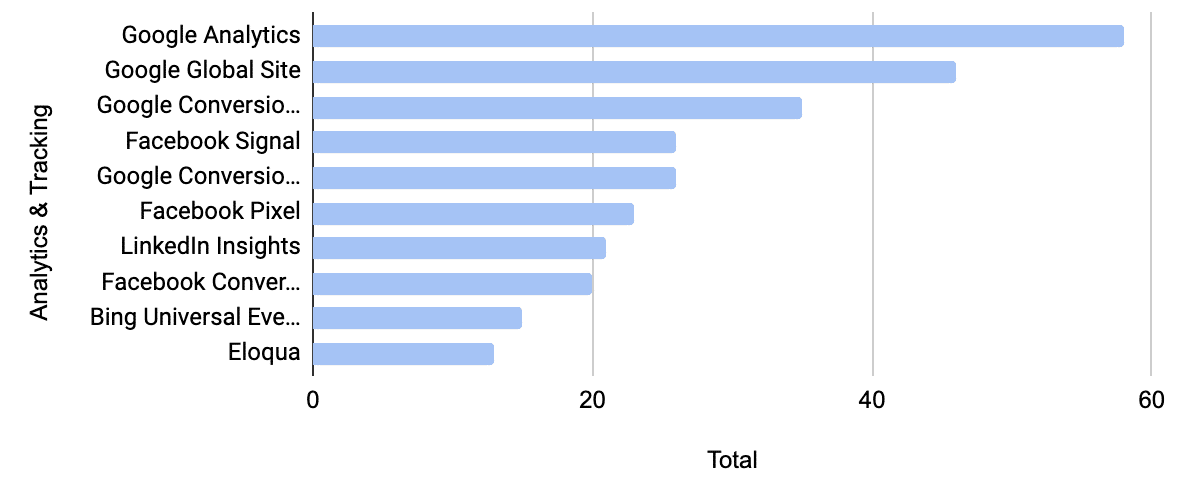
When it comes to analytics and tracking tools for life science companies, Google Analytics, Tag Manager, and other pixels make up the most popular analytics and tracking plugins. Aside from these, there are a few other very popular analytics and tracking tools commonly used.

Eloqua is the most popular SaaS B2B marketing automation solution, which is offered by Oracle. Primarily Eloqua helps to automate the lead generation process and helps to increase conversions, sales, and a company’s understanding of its customers. By using Eloqua’s email automation platform, you can track open emails, customer activity, and more. We find that Eloqua is especially popular among enterprise-level companies that actually have full in-house teams to manage lead nurture campaigns, drip marketing, email A/B testing, event marketing, and more.

Marketo is the other common alternative to Eloqua, which is more geared toward small- to medium-sized businesses. Marketo has roughly similar functionalities as Eloqua, but it is about half the price-point. Full disclosure, I’m not an expert in Eloqua vs. Marketo, but there are definitely some excellent articles out there interviewing actual users to determine the key differentiators.
Pardot is the third contender here for marketing automation. Ultimately, it is ideal for Salesforce users because it is part of Salesforce and has a very tight-knit integration, which is probably the main value proposition.
CrazyEgg and Hotjar are common analytics tools that allow you to track for heatmaps and user behavior for conversion rate optimization. While my experience with CrazyEgg has been excellent, CrazyEgg lacks some of the additional functionality that Hotjar has when it comes to collecting user feedback from web visitors.
NewRelic is popular among more sophisticated eCommerce life science companies, but my experience with it is limited. It might be worth giving it a try, however, if you’re at a point where you see at least 30,000 users a month on your website. This number will give you significant statistical evidence.
Most of the websites using it, if not all on our list, get over 100,000 users a month. Also, NewRelic has a lot of other features and functionality that can help you monitor your software better. So, it’s worth exploring if you have a complex website.
The bottom line is that if you’re a small- to medium-sized business at the enterprise level, I’d recommend you seriously invest and up-skill your team in utilizing a top marketing automation platform, whether it be Eloqua, Marketo, or Pardot.
However, for many of the companies we work with, leaner options work well, such as MailChimp, ActiveCampaign, and more. After all, there’s no point in paying a large monthly subscription cost when you don’t have the knowledge or time to use all the features.
If you don’t use a heat mapping tool today, such as CrazyEgg and Hotjar, then I still recommend you engage in monthly or quarterly customer UX tests and interviews simply to determine how your website aligns with their customer journey.

Hotjar has the amazing ability to easily collect user feedback from your website through a simple installation. They even offer a full question bank to help get you started.
4. Web Hosting Platforms
I’ll keep this one short: Amazon Web Services (AWS) is the clear leader here, and it should be. AWS provides excellent cloud computing and hosting options for any serious business. Cloudflare is an excellent choice for a CDN-network as well as for security against DDoS attacks.
Top Web Hosting Platforms Distribution across the Top 10K Websites Globally
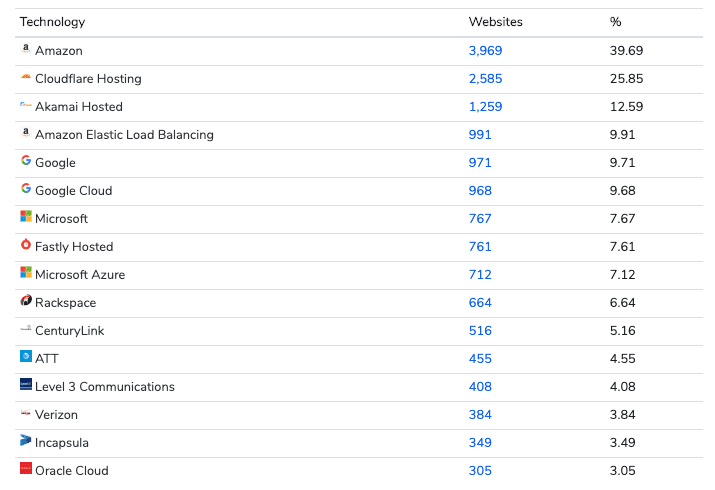
Top 10 Web Hosting Platforms Used by Life Science Companies
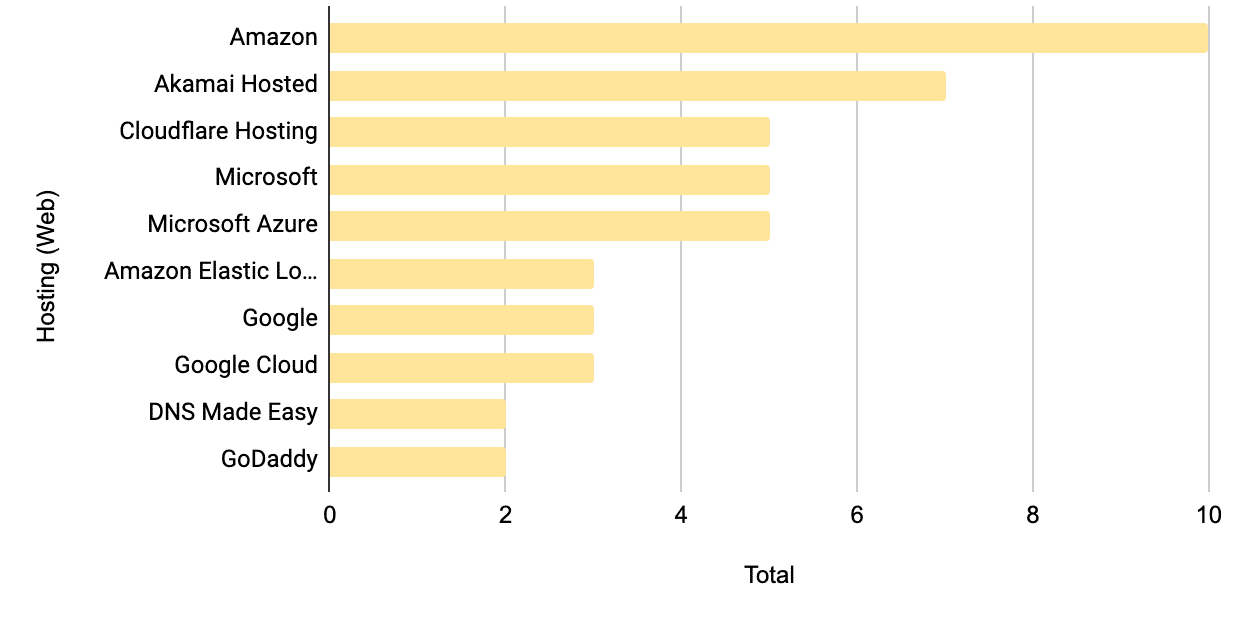
I’ve had to explain the differences of why life science companies should go with AWS so many times and how it isn’t comparable to something like GoDaddy, Hostgator, SiteGround, and these other web hosting services.
The bottom line is that comparing AWS to those services is just a strange comparison. AWS is meant for seasoned developers who know how to set up and run a technical, high-performance hosting environment, whereas a small non-technical two-person business can probably get away with using GoDaddy.
No, sorry, you can’t host your Magento Commerce webshop with 10,000 SKUs on a $12/month plan.

Our Pick: Best Life Science Hosting Provider |
|
|---|---|
|
Amazon Web Services 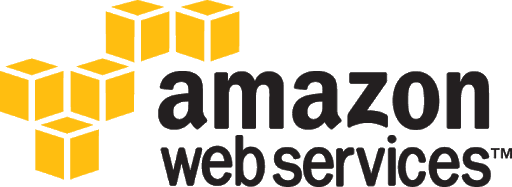
|
|
Final Thought
I hope this information was useful for you to best determine the web platform, analytics tools, and more for your life science company.
Although all the information gathered here is publically accessible through BuiltWith, SimilarWeb, and SEMrush, we wanted to share with you the option to download the complete dataset here. We’ve redacted the names of the companies profiled just to be thoughtful toward the organizations.
At Supreme, we’re constantly trying to innovate and push the limits when it comes to digital marketing while also being practical, based on the needs of individual companies. Feel free to reach out for more details or send an email for comments or questions.
Related Posts
Get a Quote or Ask a Question
- Curious about our process or pricing?
- Need help getting buy-in?
Contact us right away — we’d love to help.
Let’s take a look at your website together and figure out your best options for business growth.

Contact us right away — we’d love to help.
Let’s take a look at your website together and figure out your best options for business growth.

